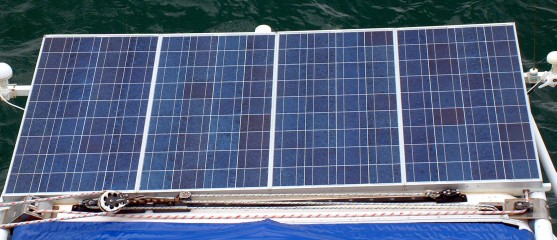
Four 120 watt panels fit nicely above our davits, aft of the mainsail track.
Note that nothing is allowed to shade the panels.
|
Cruising Info Equipment Pages |
Solar Panels
The allure of photovoltaic panels on board is extremely compelling: free electricity, without the noise or maintenance associated with engines or even wind chargers. But installing panels so you get the most out of them is not as simple as many folks think. A few simple tips will help you get the most out of your installation. Subjects discussed in this article include:
Panel Location
Something a lot of people don't realize is that it doesn't take much shadow
over your solar panels before they stop working. 12v (nominal) Solar panels today
typically consist of 36 cells. Each silicon cell contributes just under
half a volt (0.48v) when the sun is shining on it. But if a cell is
shaded, it becomes a (rather leaky) diode, so instead of contributing half a
volt, it actually absorbs almost 3/4 volt (0.7v). These numbers are
inherent properties of silicon, the main element in solar panels. So shading a single
cell decreases the output voltage of a panel by over a volt (~1.2v). This
is usually enough to effectively shut that panel down, so it's producing no current
at all. Certainly shading 2 cells will prevent it from charging a 12v battery.
 Four 120 watt panels fit nicely above our davits, aft of the mainsail track. Note that nothing is allowed to shade the panels. |
So it's important to make sure that your panels get shaded as little as possible. Even a single rope over a panel will have a devastating effect on that panel's output. We often see other boats with panels under radar arches, or next to wind chargers, and the owners wonder why their panels don't put out as much as they expect. If you want to have a wind charger as well as solar panels, you have to make sure that the wind charger is as far away from the panels as possible, and no higher than necessary. If your panels are under your boom, make sure your boom is swung out to the side whenever you're at anchor.
Are solar panels really worth it?
Photovoltaic panels are expensive but they are getting more reasonable. We
paid US$550 each for four 120 watt
Kyocera
panels in 2001 ($4.58/W). In 2009 we could get 135W
Kyocera
panels for about $420 in the US ($3.11/W), a reduction of 32% in 8 years. And in
2017 we could get flexible panels for only US$1/watt! Each panel will give us about
40 Amp‑hours per day, or about
(40Ah/day) x (13v) x (30 days/month) = 15KW‑hours
per month. How long it takes to amortize that depends on how you generate your
electricity and how much that costs you. Those numbers are very different for each boat
but it's not hard to figure out (only 3 values are needed - see below). How much does it cost you
to generate a kilowatt‑hour using your current scheme? We generally
figure that the total cost of running an engine is about twice the fuel cost,
which makes things easier. For the purposes of these calculations, I'm
going to use a battery voltage of 13v, which is about our average battery voltage.
For example, our alternators probably average about 50 Amps and the engines burn about 1.5 liters/hour. With diesel currently costing about $.60/liter, we figure it costs us about (2) x (1.5 L/hr) x ($.6/L) = $1.80/hour to generate (50A) x (13v) = 650W, or ($1.80/hr) / (.650KW) = $2.75/KW‑hour (very expensive compared to the $.10/KW‑hr we pay at home for domestic electricity). So it would cost us ($2.75/KW‑hr) x (15KW‑hr/month) = $41.25/month to equal the output of 1 solar panel. At that rate, we pay off a $420 panel in $420 / $41.25 = 10 months! For a $110 flexible panel, it's only 3 months! OK, generating electricity with alternators on big diesel engines isn't very efficient, and we don't get 30 sunny days per month, but you get the idea. Plug in your own numbers for fuel cost, fuel consumption, and electrical output to arrive at your own amortization time.
But for us, the joy of not having to run an engine at all has been well worth the cost of our solar array. Plus, your boat will gain resale value by installing solar panels, as the rigid ones generally don't wear out. Kyocera panels carry a guarantee that they won't lose power over time (like 25 years!) so your investment is protected to a certain degree, and they honor that guarantee. In fact, Kyocera replaced our panels (flying the refurbished replacement panels to Malaysia at their expense, after 8 years!) as they've had some problems with internal connections in panels sold in late 2001. That's quite an amazing commitment to quality, especially given these tough economic times. (Kyocera is NOT a sponsor of this site, much as we'd like them to be.)
How many solar panels do you need?
Practically speaking, most folks are limited by how much space they have for
mounting solar panels. So most will buy as many panels as they can mount,
and fill in any electrical shortfall with with some other generating system. So then the issue
becomes maximizing your watts/dollar. A casual perusal of the web shows
that the bigger the panel, the better your watts/$ ratio. So your best
bang for the buck would be buying the biggest panels you can fit on your boat. This is
what we did, and 120W
Kyocera
panels were the biggest 12v panels we could find in 2001. Today, higher voltage panels and using an
MPPT controller to charge the batteries make more sense.
 Both tilting and fixed panels mounted in different places on 50' (15m) Peregrinata |
Solar Panel Power
Most people know that Power equals Amps times Volts (P=IV, where I is the
symbol for current - yes, it's silly, but that's the way it is). So
Current equals Power over Voltage (I=P/V). Therefore, many folks think
that if you buy a 120 watt panel, you'll get 10 amps at 12 volts. After
all, I=P/V=120/12=10 Amps. But most of today's conventional 12v solar panels
have 36 cells in series, and develop their maximum power at over 17 volts!
This is so there's enough voltage to run a charge controller, and also to allow
the batteries to get up to full voltage (15+ volts if you want to do an
"equalization" charge on wet-cell batteries) even when the panels get
hot and their voltage droops.
Energy Budget - Consumption
Working out how many Amp‑hours of electricity you consume is tedious but fairly
straightforward. A spreadsheet will help a lot to tabulate and sum up your
results. Go through all the electricity consumers on your boat
(computers, lights, pumps, fridge, freezer, watermaker, etc), find out how much current each one of them
draws (consumes) individually and estimate how long they're active for each day.
Some things like water pumps are tricky but if you know how much water you
usually go through in a day and you can work out how many liters/minute your
pump pumps, then it's not too hard. Fridges can be even trickier but you
can wire a small battery powered clock to a voltage divider circuit to give you
run time (this is also a good way to spot trouble before it gets out of hand). Many things will have to be
estimated, but your estimates can be refined later.
Leave autopilots and running lights out for the time being, or create another
spreadsheet for consumption while on passage, as
the numbers are likely to be quite different. Multiply your amps by the time to give you a column of
Amp‑hours (or Amp‑minutes) and then sum that column to get the amp‑hour
(abbreviated Ah) figure for everything on your boat.
That's how many Amp‑hours you go through in a given day.
That's the easy part ![]()
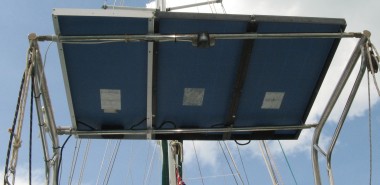 Basic mount above davits on a monohull |
Chris did this for us as part of a school project soon after we moved on board Ocelot and determined that the 4 of us used a bit less than 130 Ah on a normal day (back in 2002). He published his figures on the Consumption pages of his Energy Budget, along with some of the assumptions he made. Use his spreadsheet as a model if you'd like.
Energy Budget - Production
Figuring out how many Amp‑hours a solar panel will give you is much more
complicated. The problem is that the glass fronts of the panels are fairly reflective,
the panels are fairly temperature sensitive (they give less power in hot
climates, a fact not widely published), and even a little cloud will
dramatically affect panel output. Most quality panels these days use an etched
glass that minimizes reflections somewhat. If you mount your panels so they
tilt towards the sun, you can get much more out of them.
If you go to Chris's
Energy Production pages, you'll see that our 120W (nominal) panels give
us just over 37 Amp‑hours each on a sunny day in St. Martin (where these numbers
were gathered). Chris did this by measuring the current every 15 minutes for an entire day, plotting the values,
and integrating the area under that curve. Our four 120W panels generate a total of about 150 Ah on a good day,
so we often have some surplus power to help carry us through periods of low
sunlight (cloudy days, etc). This works out fairly well for us when we're
sitting still or even day-sailing (when the few minutes of engine use at the
beginning and end of the sail help to keep the batteries topped up). It's a
rare day indeed when we have to run an engine for the sole purpose of charging
batteries. If we pull into a marina, we usually charge them for our
electricity! ![]()
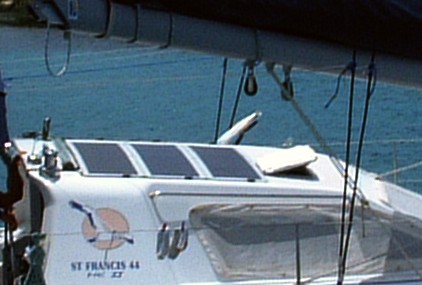 Hot cabin-top panels on Scud. Note boom pulled to side. |
How much will my panels give me?
Most cruisers know that equipment performance on our boats often bears little
resemblance to published literature, especially advertising literature. Advertisers
want to make their products look good, so they spin their prose to accomplish
that. But we've found that each
of our 120W (nominal) panels generates a bit less than 40 Ah/day into our
batteries on a good day. So I would think that if you take the nominal wattage of your
panels and divide that number by 3, that should give you a rough idea of how
many Amp‑hours each panel will give you on a sunny day in the tropics.
This is somewhat crude and approximate, but since it's based on empirical
measured data it's also probably fairly realistic (and I haven't seen anyone
else do this sort of analysis). I don't have any hidden agenda here - I'm just trying to provide some
useful information. So Watts/3=Amp‑hours is a good ratio to remember.
Passage-making
Note that our panels do not really provide enough power for us when
we're on passage (sailing day and night). Being a catamaran, we can't fit
a wind‑powered self-steering system. Our targa‑bar upsets the wind‑flow
too much, so we have to use an electric autopilot. Our autopilot and associated instruments
consume about 4 Amps or almost 100 Ah/day, so our daily
consumption goes way up. Also, the panels themselves are generally shaded
by the sails for about half the day so they're generating much less power. This
means that we usually run an engine for an hour or so in the morning when we're
on passage, but historically that's only 7% of the time or about 25 days/year.
One possible solution here would be a towing or wind generator, but that's a whole new subject.
Fixed or tilting mounts?
One of the biggest sources of power-loss in a solar system is reflection off the
glass that covers the cells. If the sunlight is reflected away, it's not
going into the silicon to make electricity. Most good quality panels now
microscopically etch their glass covers to minimize reflection, but there's
really no substitute for pointing your panels directly at the sun. There
are 2 problems with this: moveable mounts are usually weaker and more
expensive than fixed mounts, and the panels have to be adjusted by hand several
times every day, especially if the boat is swinging at anchor (although leaving
the panels horizontal should allow them to perform as well as fixed panels).
Note that, on land, the optimal angle to maximize output is to point your panels
south if you're in the northern hemisphere (or north if you're in the south) and
angle your panels to the same angle as your latitude. This will
minimize reflections over the course of the year.
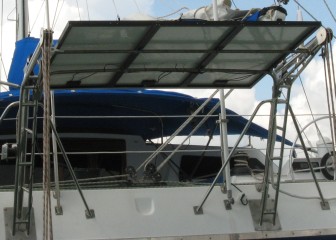 Common mount above davits on a catamaran |
We chose to mount our panels in a fixed, horizontal orientation above our dinghy davits. Our panels are big enough that they present a respectable amount of windage, and making them movable would have been pretty difficult. This minimizes our hassle factor, but does limit our output somewhat.
How do solar panels work?
Traditional solar cells are extremely pure silicon in an extremely uniform
crystalline matrix. One side of the cell has a tiny bit of boron baked
into it, and the other side has a bit of phosphorous baked into it. A
silicon atom has 4 electrons in its outer shell, while boron only has 3 and
phosphorous has 5. This means that the matrix on the phosphorous side has
too many electrons, while the boron side has too few. Sunlight hitting the
phosphorous side tends to kick loose these extra electrons, which, if picked up by the metal traces on top of the cell will travel
through your circuit to the other side of the silicon and fall into one of the electron "holes" on the boron side.
This produces a flow of current (electrons) which is picked up by thin metal
traces laid down on the surface of the solar cell. The cells are connected
in series to produce the desired voltage. OK, purists will scream that
I've glossed over some very complicated points here, but this explanation is
only meant to give some insight to interested laymen. Those who want more
information can read it on
Wikipedia.
It is a property of silicon that when doped with minute quantities of boron and phosphorous, it will produce ~0.5v when exposed to sunlight. But a diode is simply silicon doped in this way, so solar cells are really large (and somewhat leaky) diodes. If you try to pass current through a cell (with no sunlight) then you'll see a ~0.7v drop in voltage, just like a diode. If you expose this doped silicon to sunlight, then the amount of current produced is proportional to the amount of sunlight and the area of exposed silicon (with a conversion efficiency of about 20%). More sunlight (or larger cells) will produce more current. Connect the cells in series (as in a solar panel) and you get higher voltages, but more cells doesn't increase the current. Increasing the sunlight (or the cell size) will increase the current, but the voltage doesn't change significantly.
If you look at the current vs. voltage curves for solar panels, the voltage remains relatively flat, dropping a bit as more current is extracted (but not much) until you reach a "knee", and then it falls to zero volts quite quickly at higher currents. If you plotted lines of constant power on that current/voltage chart, they'd be hyperbolas with their axes oriented at 45 degrees, approaching each axis asymptotically at the extremes. The maximum power point for the solar panels is where a hyperbola just touches the knee. This is not quite the open-circuit voltage (Voc), nor the short-circuit current (Isc), but it's relatively close to both, as the knee is relatively sharp. Voc for a 12v panel (36 cells in series) is about 21v, but the maximum power voltage, Vmp is usually 17‑18v for that panel. For a 72 cell, 24v (nominal) panel, Voc would be about 42v and Vmp should be about 35v.
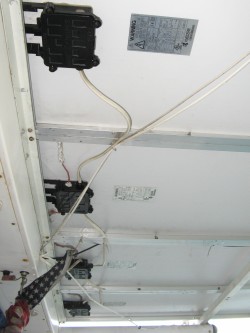 Ocelot's panels from below |
The effects of heat on solar panel output:
How much current a solar panel delivers depends not only on how much light is
getting to the silicon, but also on how hot it is. This inconvenient fact is often ignored or glossed
over in promotional material. The specifications for our panels say they'll
deliver 120W when they're in 1,000W/m2 of sunlight.
Noon in the tropics will sometimes produce 1KW/m2
of sunlight, so that's a reasonable number for manufacturers to use.
But the small print says that we'll only get that much power if the panels are
at 25°C (77°F). This is highly misleading, as there's no way that a panel
sitting in 1,000W/m2 of sunlight will stay that cool, especially in the
tropics. We haven't put a thermometer on our panels but they get pretty
hot, even though they're exposed to the breeze. The more reputable
manufacturers will publish a table or graph of how current (and therefore power) decreases as
temperature rises.
For instance, Kyocera's specifications for their 135W panels say that at more normal operating conditions of 800W/m2 of sunlight and cell temperatures of 49°C (120°F) their maximum output power drops by 30% to 95W, current drops by 20% from 7.63A to 6.1A, and the maximum power point voltage drops by 12% from 17.7v to 15.6v. This last is especially useful for correctly programming a maximum-power-point tracking regulator. One reason we like Kyocera is that they don't seem to be afraid to publish these more realistic numbers.
But from a practical perspective, it's important to keep your solar panels as cool as you can while still leaving them in the tropical sun. Don't bolt them down to the deck. Instead, mount them in places where they get good airflow around them, to cool them down as much as possible.
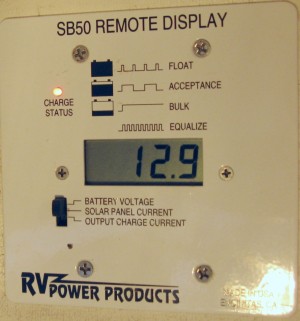 Solar controller panel and battery voltage |
Solar Charge-Controllers
Solar controllers are essentially battery chargers, limiting the voltage that is
fed to your batteries so they don't over‑charge. You can destroy a battery
bank very quickly if you over charge it for long enough, especially if you use
Gel or AGM type batteries. So a charge controller, while not strictly
necessary, is usually a good idea. Many basic controllers can be had for
$50 or so. A good solar controller will be fairly sophisticated and will
provide you with multi‑phase charge cycles. First a bulk phase, where all
the power is fed into the batteries, then an Acceptance phase (sometimes called
other things as there's little standardization) where the voltage is limited to a
predetermined value, and finally a Float phase where the controller decides
that the battery bank is fully charged so it drops the voltage to about 13.5v so
the batteries stay full but not over‑full. Good controllers will have
programs for all the different battery types (wet, gel, AGM, and sometimes LiFePO4) and some will
come with temperature sensors for the batteries, as a battery's finish
voltage is temperature dependent. Also, a good charge controller should
not sense the battery voltage through the charging lines, as these may develop
some resistance (corrosion, etc) which will affect the controller's ability to
accurately determine the battery's voltage. We're talking small fractions
of a volt here. Instead, the controller should have separate sense lines
that sense the voltage of your battery bank but don't actually carry any
current. (Good alternator regulators and AC battery chargers will have
similar features.)
But the best solar controllers are maximum-power-point tracking (MPPT) controllers. These run the panels at their maximum power point (typically 15.5‑18v, or higher if you wire your panels in series) and use a DC‑DC converter to then charge your batteries (13‑15v). As conditions change, they track the maximum power voltage of the panels, and run them at that maximum power point. The DC‑DC converter is typically better than 90% efficient, and it's able to give you more current into your batteries than your panels are actually producing. This sounds like magic but it's not. If your panel is producing, say, 6A at 16v (96W), the DC‑DC converter changes that to something like 6.6A at 13.8v (91W) to charge your batteries. Power is conserved (in fact, a bit is lost as heat in the converter) but there's still a 10% net current gain into your batteries. Most advertisers claim a 20% boost in current, but our experience is that you'll typically see more like a 10% gain. MPPT controllers need to scan for the maximum power point at intervals, and some are better at this than others. We've heard that Outback controllers can take 45 seconds to scan, while MorningStar controllers only take a few seconds. The main problems with these types of controllers is cost (often several hundred dollars) and that the DC‑DC converter is a switching type that generates RF noise that you'll hear in your SSB radio. We have to either turn our solar panels off or bypass the controller when we're using our SSB radio.
In any 3 stage battery charger (solar, alternator, or AC), the decision of when to switch from Acceptance to Float is critical, or you can damage your (expensive!) batteries. Most chargers depend only on time, which is cheap, but a poor algorithm. The best way is to measure the current going into the battery (with a separate shunt) and to switch from Acceptance to Float when the current required to keep the batteries at the Acceptance voltage drops to about 1% of the amp‑hour capacity of the batteries. All lead/acid batteries (wet, gel, or AGM, but not LiFePO4) start out accepting a lot of current, but as the batteries get more charged, the current required to keep the bank at Acceptance voltage drops. So if you have a 500Ah battery bank, then the charger (solar controller) should switch from Acceptance to Float when that current required to keep the bank at the Acceptance voltage drops to only 5A, to prevent over‑charging the batteries. Most controllers, like MorningStar, only use a time‑based approach, while our Blue Sky controller monitors the actual current going into the batteries (not just the current being produced by the solar array).
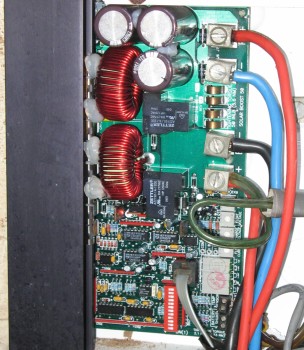 Interior of our Solar Boost 50 Controller |
If you're always going to use all of the power that your solar panels generate, then a solar controller isn't strictly necessary. But most of us leave our boats now and then for extended excursions ashore. If you over‑charge your batteries, you can kill them very quickly. Most solar controllers are fairly cheap and many provide some useful performance instrumentation (battery voltage, solar output, etc) as well.
Shading Issues
Solar panels are just a string of photovoltaic cells wired in series. Anything wired in series will have the same
current throughout, including solar panels. But shading a few cells doesn't decrease current significantly - it
only makes the shaded cells go from producing voltage (~0.5v) to consuming voltage (~0.7v, like a diode). But the
current doesn't change a lot, just the voltage. So when some cells are shaded in a series string of cells, the
voltage will go down (by ~1.2v/shaded cell). For 1 string of cells connected to an MPPTC, when the voltage changes
(by shading, for instance) the MPPTC should track that change and operate the string at the new MPP voltage.
That's what it's designed to do. The power (current x voltage) will drop slightly because the voltage has dropped.
Parallel or Series Connections?
If you connect all your panels in parallel, then your MPPT controller will run all the panels at the same Maximum Power
Point voltage. But if one gets shaded, even just a little bit, then its voltage will drop and it won't be able to
get to that MPP voltage, so the entire output of that panel will be lost. But only that one panel's output will be lost.
If you connect your panels in series, then several nice things happen. The DC‑DC converter has more voltage to work with, so it becomes more efficient. The wires from the solar panels to the controller are running at a higher voltage, so they're not carrying as much current, so they don't have to be as big and your wiring losses go down. And shading a few cells means that the series string is still well above the battery's charging voltage, so the string continues to produce meaningful, if reduced, power.
But the input transistors on an MPPT controller have voltage limits, so if you have a lot of panels, especially if they're 24v panels, you often can't run them all in series. And if you have several series strings feeding into the same MPPT controller, and one panel gets a bit shaded, then that whole string won't be able to get to the MPP voltage of the other strings, so the whole string will be dropped.
So the best solution is to wire your panels in series up to the maximum voltage your MPPT controller can take, and for each string to have its own MPPT controller. This way, if cells get shaded, that MPPT controller will run that string at the new, lower, MPP voltage, but it will still be able to contribute power to the battery. Yes, this solution gets expensive if you have lots of panels, but luckily, MPPT controllers are coming down in price, and the new ones can handle higher input voltages (more panels in series).
Note that if an MPPT controller says it has a maximum input voltage of, say, 50v, that does not mean that you can run 4 12v panels to it. The open circuit voltage of a 36‑cell 12v (nominal) panel is about 22v, so you could only connect a pair of 12v panels to a 50v MPPT controller, not 4.
Rigid or Flexible Panels?
This will probably be decided by mounting issues on each boat. Flexible panels are relatively new, and they offer
several advantages, but they also have significant disadvantages. They can mount on pretty much any flat surface,
they can often be walked on, and they're generally much cheaper to buy and to ship than rigid panels. In 2017, we
were able to buy flexible panels (to supplement our existing rigid panels) for only $1/watt! But mounting them by
sticking them down means that they have no cooling underneath, so they'll run quite hot, which will decrease their
performance, sometimes markedly. And the flexible plastic covering the panels doesn't last as long as the glass
faces of rigid panels, so their output will drop as the plastic gets darker in our intense tropical UV. Our rigid
Kyocera panels have a 25 year output guarantee (as do many other panels) but flexible panels generally have no such
performance guarantee. Our original panels are only supported at the front and about 2/3 of the way along their
length, and you can't do that with flexible panels.
So each type has its place. Rigid panels generally last longer and give better performance, but flexible panels are cheaper and often easier to mount.
What solar system do we have on Ocelot
Being a catamaran, we have a lot of relatively usable space for mounting photovoltaic
panels. Above the bimini, above the davits, above an aft-mounted
electronics arch, or even above the saloon are common mounting locations, but
we've even seen them bolted to the deck (which looks quite dangerous to both
panels and people). We've also seen monohulls attach solar panels to
their lifelines.
We chose to mount our rigid panels above our dinghy davits, where they should even be out of the way of the boom most of the time. We had to remove our radar arch to accomplish this and move some VHF and GPS antennas around, but that was fairly easy. We strengthened the davits themselves because we didn't want them breaking if the dinghy was suddenly filled with water from a breaking wave (as happened to us north of Columbia). The forward end of the panels could be held up by our targa bar, so all we had to add was an aluminum bar at the aft end of our davits to support the back end of our panels. Electrical connections could go through the targa bar.
The width of our targa bar, 2.6m or just short of 9', defined how wide our solar array could be. The length was defined by our aft support at the far end of our davits, which was about 1m from the targa bar. The panels could stick out past the aft support if the panel frames themselves were strong enough, but total panel length shouldn't be more than about 1.5m or 5'. With these physical restrictions, it became apparent that relatively long and narrow panels would fit the best. Researching what panels were available in 2001, we decided on four Kyocera 120W (nominal) panels. They're each about 25.5" x 56" (.65 x 1.42m) giving us an array width of 102" (2.59m).
In 2017, we found that the generally cloudy conditions were preventing our solar array from keeping up with our demand (although it had done so fine for 16 years!) So we bought 4 more flexible panels to mount above the bimini. As of this writing (2017) we haven't yet received or installed these panels, so we can't comment further.
Our solar controller is a Solar Boost 50 from Blue Sky Energy (ex RV Power Products) in California. It's really designed for RV use, not marine use, as the case is just painted steel. But it's a maximum power point tracking controller that provides us with a 3‑phase charging cycle and special programs for wet, Gel, or AGM batteries. It has separate sense leads, temperature compensation, a control head that shows us battery voltage, panel current, or current into the batteries, and it has lots of adjustments so we can tweak it just the way we want it. Perhaps more important, it senses the current going into the battery (not just being produced) so it only switches to Float mode when the current required to maintain Acceptance drops down to 1% of the amp‑hour capacity of our battery bank, which is the best way to handle lead‑acid batteries. The SB50 can only handle 24v (nominal) input, so our 4 panels are wired as 2 strings of 24v. It has worked very well for us ever since we installed it in early 2002. The only problem we've had (besides a bit of rust on the case) is that it generates enough RF that we have to turn it off when we use our SSB radio, but we've found that we have to turn ALL our DC‑DC converters off, including our computer power supplies, fridge motors, small inverters, and even LED lights, as they all generate a fair amount of RF.
Equipment Pages:
Cruising Info:
Top Level: Home | Destinations | Cruising Info | Underwater | Boat Guests | Ocelot | Sue | Jon | Amanda | Chris | Site Map | Make a Comment
|
If our information is useful, you can help by making a donation |
Copyright © 2000‑ Contact: Jon and Sue Hacking -- HackingFamily.com, svOcelot.com. All rights reserved.